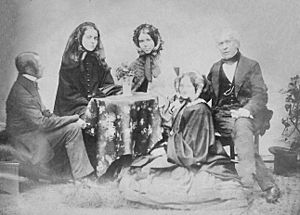Calvert Jones facts for kids

Calvert Richard Jones was a talented Welsh mathematician and painter, born on December 4, 1804. He is most famous for his beautiful paintings of the sea, called seascapes. He was also a very early pioneer in photography, taking some of the first pictures ever seen in Wales! He passed away on November 7, 1877.
Contents
Discovering Calvert Richard Jones
Calvert Richard Jones came from a wealthy family in Swansea, Wales. He received a good education, attending Eton College and Oriel College, Oxford. These were important schools in England. He was also a friend of other important people of his time, like John Dillwyn Llewelyn and Christopher Rice Mansel Talbot. This meant he knew people who were also interested in new inventions, including Henry Fox Talbot, who was a key figure in the early days of photography.
Calvert Jones: A Photography Pioneer
Calvert Richard Jones is famous for taking the very first photograph in Wales. This happened in 1841, and the picture was a special type of early photograph called a daguerreotype. It showed Margam Castle, a grand building in Wales. Even though he took this important picture, photography wasn't his main job. He was still very much a painter.
Capturing Wales and Beyond with a Camera
During the 1840s and 1850s, Calvert Jones took many photographs of the Swansea area. He also loved to travel and took his camera with him on adventures to France, Italy, and Malta. Imagine carrying all that bulky camera equipment around back then!
Inventing New Photo Techniques
Calvert Jones was also very clever and developed his own special way to take panoramic photographs. This meant he could take several pictures and then carefully overlap them to create one wide, sweeping image. This was a very advanced technique for his time!
Calvert Jones's Later Life and Legacy
In 1847, Calvert Jones inherited a large property in Swansea called the Heathfield estate. He helped develop this area, even naming a street, Mansel Street, after his brother. This street still exists today! Later in his life, in 1853, he moved to live in Brussels, which is the capital of Belgium. He eventually returned to Britain and settled in Bath. He died in Bath, but his final resting place was in Swansea, at St Mary's Church.


